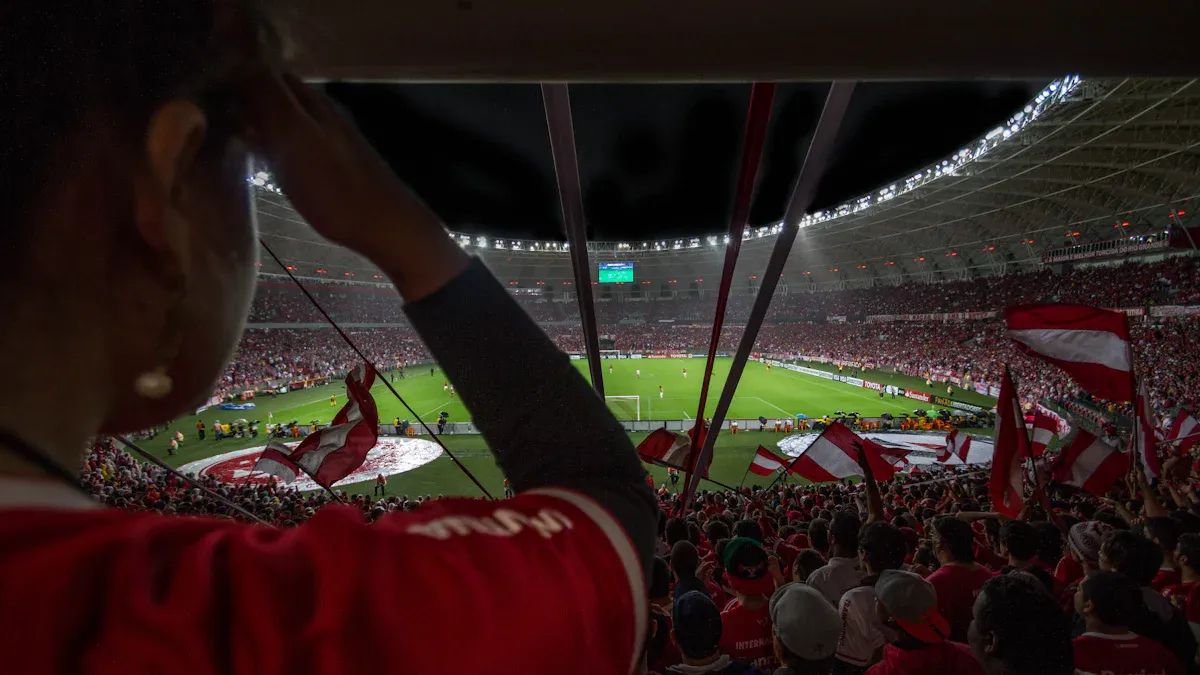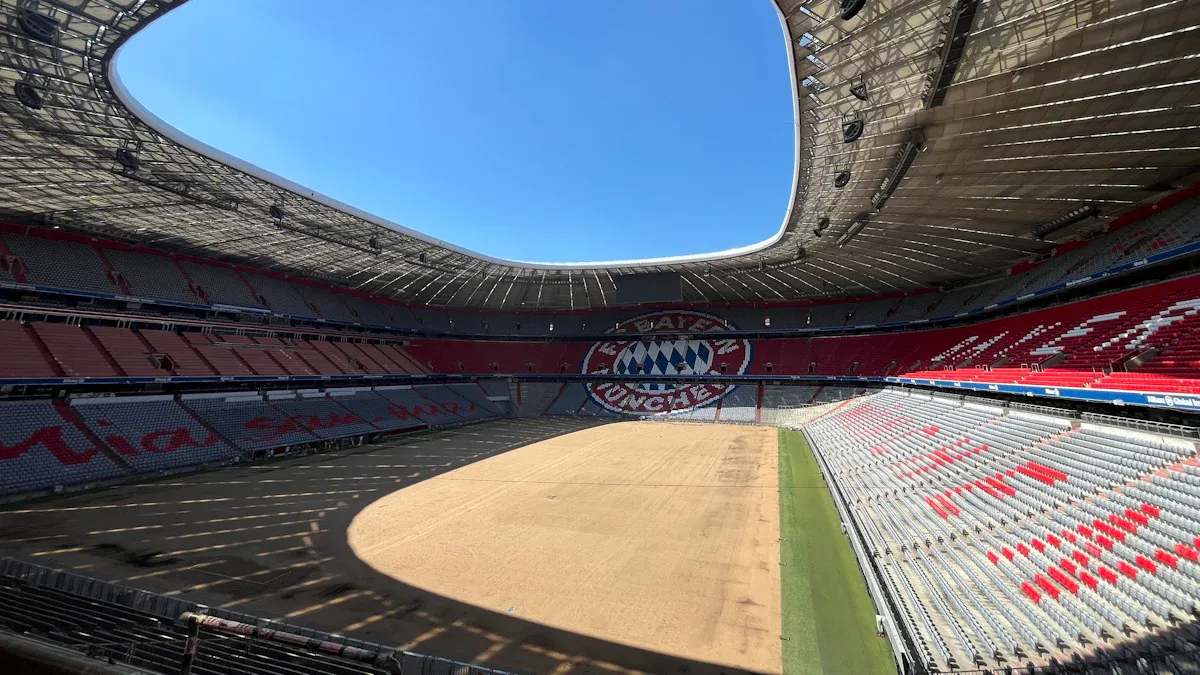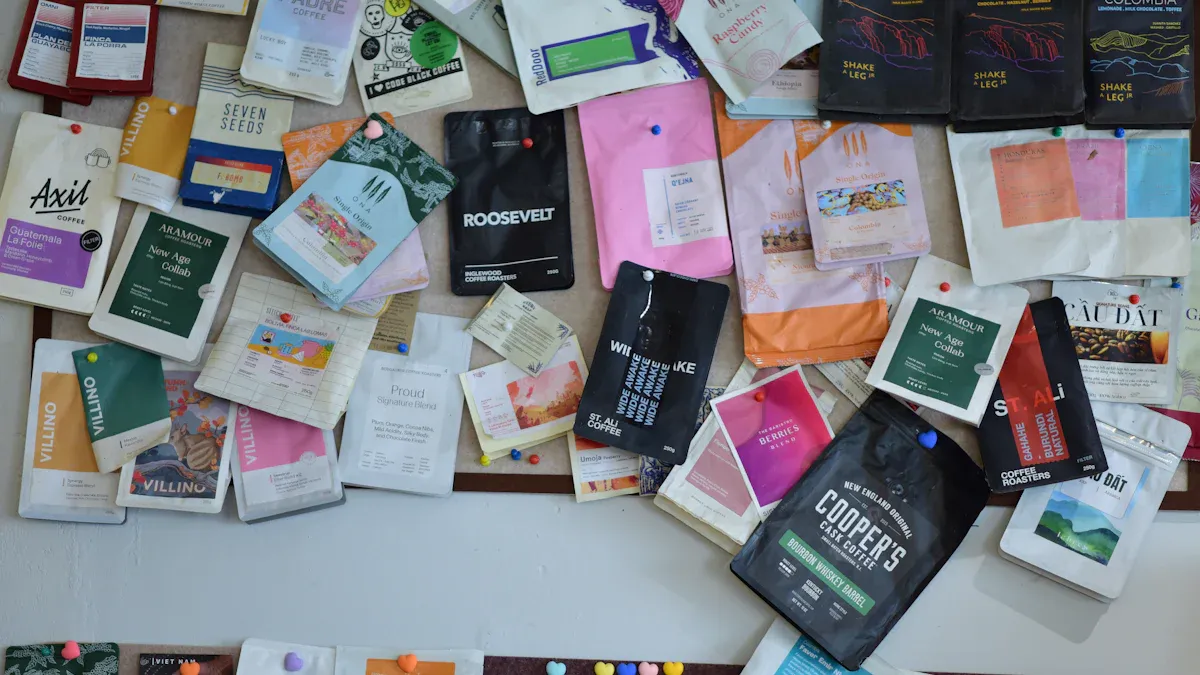
The 2026 World Cup will have a huge audience. Each day, as many people will watch as the Super Bowl. The total number of viewers could reach 6 billion. Soccer is now more popular in North America. Many different fans are excited about it. This has made more people want custom souvenirs. Recent sports events show fans like items that are personal. They also want souvenirs that are good for the planet. Fans like things that show off their region too. Brands now see chances in digital collectibles and special gifts. If you want cool merchandise, contact us. We can help you make special souvenirs for the tournament.
Key Takeaways
-
The 2026 World Cup will bring in billions of fans. This gives brands big chances to sell custom souvenirs. These souvenirs can show local culture and personal style.
-
Fans want souvenirs that are special and good for the planet. They also want items that connect to their city or team. Brands should offer products that are personal and eco-friendly.
-
Digital souvenirs like NFTs and augmented reality make collecting more fun. They give fans new ways to save and share memories during the event.
-
Brands can sell more by using online stores and premium gift sets. They can add tech features and work with local artists. This makes souvenirs unique and important.
-
Brands should start marketing early and use social media. They need to handle licensing and supply chain well. This helps them reach more fans and stop fake products.
2026 World Cup Market Impact

Global Reach
The 2026 World Cup will be bigger than ever before. It will happen in three countries: United States, Mexico, and Canada. Sixteen cities will have games and welcome fans from everywhere. The United States will have 11 cities hosting matches, like Los Angeles, New York/New Jersey, and Miami. Mexico will have games in three cities. Canada will have two cities as hosts. There will be 48 teams and 104 matches. This will make it the largest World Cup ever.
The tournament will bring millions of visitors from other countries. Experts think the U.S. could make over $30 billion from this event. Tourism will help a lot with this money. Mexico could get $3 billion more because people will buy sports merchandise and local goods. Each visitor may spend thousands on travel, food, and shopping. This will help local shops and the souvenir market.
This event gives brands special chances. Companies can make souvenirs that show each city’s culture and style. Fans will like items that show their pride in their city and connect them to the world.
Fan Engagement
Brands have many ways to reach fans during the 2026 World Cup. Past events show that interactive things work best. Companies have used pop-up events, VR zones, and meeting famous people to get fans excited. These activities help fans join in and make them like the brand more.
-
Experiential marketing, like fan zones and cool tech, makes great memories.
-
Social media and live streaming let fans share what they do right away.
-
Mixing in-person events with digital content helps reach more people.
The 2026 World Cup lets brands connect with many different fans. By using both real and online experiences, companies can make a big impact. They can also create souvenirs that fans will want to keep.
Key Trends
Personalization
Personalization is changing the custom souvenir market a lot. Fans want things that are special and just for them. Younger fans are 21% more likely to buy these souvenirs at big sports events. They want products that help them remember the event and show who they are. Brands now sell keychains, phone cases, and wristbands with names or team logos. Some even have special messages. This helps brands get closer to fans and make souvenirs that last.
Sustainability
Sustainability is now very important for brands and buyers. Many people pick souvenirs made from eco-friendly materials. Companies are working on making things in a fair way and showing where their stuff comes from. The table below shows how sustainability is changing sports merchandise:
|
Aspect |
Details |
|---|---|
|
Market Share by Region |
Europe: 28% of global Sports Consumer Goods Market; North America: 35% |
|
Consumer Demand Trends |
More people want eco-friendly and sustainable products |
|
Brand Strategies |
Brands focus on making things in a green way and teaming up with environmental groups |
|
Notable Brand Examples |
Adidas made 15 million shoes from recycled ocean plastic; Lululemon uses recycled polyester |
|
Market Impact |
Sustainability helps brands come up with new ideas and keeps fans loyal |
|
Future Outlook |
Eco-friendly materials will be important for new chances |
Fans now want brands to help the planet. This makes companies create souvenirs that look good and are good for the earth.
Digital Souvenirs
Digital souvenirs have changed how fans save memories. Many sports fans and collectors use NFTs and AR experiences now. These digital items can be tokenized jerseys, trading cards, or game highlights. Platforms like NBA Top Shot let fans buy, sell, and trade these collectibles. NFTs also give fans special online meetings, cool content, and rewards. AR and VR make these souvenirs even more fun. Digital souvenirs give brands new ways to reach fans during the 2026 World Cup.
Regional Customization
Regional customization is a big trend right now. Fans want souvenirs that show their city, culture, or favorite team. Brands make products with local symbols, mascots, and languages. This makes fans feel proud of where they are from and closer to the event. Regional themes make souvenirs more special and increase demand all over North America.
Brand Opportunities

E-Commerce
Brands can use e-commerce to reach fans everywhere. Online stores let companies sell custom souvenirs at any time. Fans can buy products from anywhere and get them shipped home. Companies can make special online collections and early deals to get fans excited. They can also offer limited-edition drops. Custom silicone and PVC products, like keychains, fridge magnets, phone cases, and luggage tags, are great for online sales. These items are light and easy to ship. Fans who want something special will like them. E-commerce helps brands learn what customers like. This helps them make better products later.
Tip: Brands can use social media ads and work with influencers. This helps more people visit their online stores and buy souvenirs.
Premium Gifts
Premium gifts are popular with fans and business clients at big events. Many companies make special gift sets for VIPs, sponsors, and guests. These gifts often have fancy tech gadgets, tasty snacks, and things you can customize. The table below shows some top premium gift types and examples:
|
Gift Category |
Examples |
|---|---|
|
High-end Tech Gadgets |
Samsung Galaxy Watch 5 Pro, Fitbit Versa 3, Bose QuietComfort 45 headphones, Samsung Galaxy Buds 2 Pro, Apple AirTag Travel Tag Sets |
|
Gourmet Snacks |
Cookies, coffee, truffles, granola |
|
Customizable Items |
Drinking glasses, stainless steel bottles |
|
Tech Accessories |
Wireless Bluetooth speakers, sustainable laptop sleeves |
Gift sets like the Fitness Fanatic Gift Box or the Bose & Cookies Gift mix tech and treats. Premium hospitality packages for the 2026 World Cup often have special souvenirs, local food, and cool experiences. Brands can add custom silicone or PVC items, like branded keychains or wristbands, to these sets. These souvenirs help guests remember the event and make them like the brand more.
Tech Integration
Technology is changing how fans enjoy souvenirs. Brands now use NFTs, AR, and VR to make digital collectibles. Fans can own and use these items. For example, companies make NFT sets with 3D models for fans to use as avatars. Some brands give out official highlight moments as NFTs. Fans can collect and trade them. Augmented reality lets fans see digital mascots or team logos with their phones. Virtual reality lets fans join events or see digital items in a cool way.
Note: Tech integration makes souvenirs interactive. Fans can share these moments online. This helps brands reach more people and make more money.
Local Partnerships
Working with local artists and makers makes souvenirs feel real. These team-ups help brands make products that show each city’s culture. Working with local talent helps the economy and builds trust with buyers. It also shows brands care about fair sourcing and doing good. Local partnerships can make cool designs, like city keychains or mascot fridge magnets, made from good silicone or PVC.
-
Benefits of local partnerships:
-
Make souvenirs more real and special.
-
Help local economies and give artists a chance to shine.
-
Build trust with buyers and make the brand look good.
-
Support local culture and help tourism.
-
Brands should learn about local culture, talk clearly, and celebrate wins together. This way, they can make souvenirs fans will love long after the 2026 World Cup.
Case Studies
Past World Cups
World Cups have started many trends in souvenirs. Brands and event planners use mascots and fun items to reach fans. Here are some important examples:
-
England 1966 – Willie: Willie was the first mascot. He was a lion wearing a Union Jack shirt. This started the mascot trend and made him very popular.
-
Mexico 1970 – Juanito: Juanito was a boy with a sombrero. He showed off local culture and got fans excited.
-
West Germany 1974 – Tip and Tap: These were twin mascots. They were on bags and other things. This helped people notice the brand more.
-
Argentina 1978 – Gauchito: Gauchito was a boy dressed like a horseman. He showed local traditions.
-
Spain 1982 – Naranjito: Naranjito was an orange mascot. He was on lots of souvenirs and fans remember him.
-
Germany 2006 – Goleo and Pille: Goleo was a lion and Pille was his football friend. They were on many promo items.
-
South Africa 2010 – Zakumi: Zakumi was a leopard with the country’s colors. He stood for local animals.
-
Brazil 2014 – Fuleco: Fuleco was an armadillo mascot. He mixed soccer and nature themes.
-
Russia 2018 – Zabivaka: Zabivaka was a wolf mascot. Fans picked him online and he got lots of attention.
-
Qatar 2022 – La’eeb: La’eeb was a mascot that looked like local clothing. He became very popular on social media.
Brands also made cool things like glasses that change color and special ceramic sets. These help fans remember the games and feel close to the event.
2026 World Cup Innovations
Brands want to try new things for the 2026 World Cup. Companies like Fashion Style Craft Gifts will have many custom souvenirs. These include clothes and useful items. They let fans and brands make their own designs. They care about fair work and the planet. They use good materials and safe ways to make things.
-
Soccer scarves will have bright colors and flags.
-
Designs will show culture from the U.S., Canada, and Mexico.
-
Some scarves will honor famous players or big moments.
-
Scarves may have QR codes for digital info and schedules.
-
Many scarves will use recycled stuff to help FIFA’s green plans.
-
Fans and clubs can make scarves special for themselves.
These new ideas mix old ways, tech, and caring for the earth. Big and small brands can use these tips to make souvenirs fans will love.
Challenges
Licensing
Brands have many problems with licensing and intellectual property. They need to get trademarks, logos, and slogans before making souvenirs. Each agreement says how brands can use official marks and what they can make. It also explains how royalties work. Companies must follow strict rules for branding and packaging. They need to work with rights holders to get designs approved.
-
Brands have to watch for people using their rights without permission.
-
Legal actions, warning letters, and online tools help stop fake products.
-
Companies must handle legal problems, reports, and rules to keep their brand safe.
-
Licensing types include trademark, character, celebrity, and event licensing. Each type has its own rules.
Tip: Brands can lower risks by having clear agreements, checking often, and talking with rights holders.
Supply Chain
Problems in the supply chain can slow down making and sending souvenirs. Not enough materials, worker problems, and shipping issues can cause delays. Shipping delays, crowded ports, and strikes can stop products from getting to fans.
-
These problems can make things cost more and harder to find.
-
Issues can happen at any step, from getting materials to sending products out.
-
Causes include bad weather, tech problems, and changes in demand.
Brands can make their supply chain stronger by using more suppliers, better inventory, and tracking shipments. Data helps guess what fans will want and stops shortages.
Counterfeiting
Counterfeiting is still a big problem for World Cup souvenirs. Fake items can hurt a brand’s name and lower sales. Brands use different ways to fight fakes:
-
Security features like holograms, QR codes, and special labels prove items are real.
-
Watching online stores and social media helps find fake goods.
-
Working with police and other groups helps catch fake products.
-
Registering trademarks and working with lawyers protects brand ideas.
Note: Brands should teach fans to buy only from official places and use new tech to keep souvenirs safe.
Maximizing Engagement
Social Media
Social media helps brands talk to fans before and during the 2026 World Cup. Teams and companies use Instagram, TikTok, and Twitter to post news and videos. They also make polls that fans can answer. These sites help fans feel close to the games and to each other. Brands work with athletes and influencers to reach more people and build trust.
-
Fans can join live chats and share their own posts.
-
Short videos and live streams make fans excited.
-
Brands use hashtags, challenges, and contests to get fans involved.
Athletes use their pages to tell stories and talk to fans. This makes fans feel part of the action and helps sell more souvenirs.
Limited Editions
Limited-edition items make fans excited and help brands sell more. Fans want special things that remind them of big moments. Brands make unique products for important games or players. These ideas help more people see the brand and make fans buy fast.
|
Aspect |
Evidence Summary |
|---|---|
|
Sporting Merchandise Boom |
More people buy sports items during World Cups. |
|
Limited-Edition Merchandise |
Special offers turn short-term buyers into loyal fans. |
|
Global Branding Opportunities |
World Cup branding reaches fans all over the world. |
|
Social Media Buzz |
Fun online posts and fan content help more people see the brand. |
|
Sponsorship and Endorsements |
Working with teams and athletes makes the brand more known. |
|
Emerging Trends |
New tech and cool experiences keep marketing interesting. |
Brands like Supreme and Starbucks show how special drops make fans excited and loyal. During the World Cup, these plans help brands get noticed and connect with fans.
Early Campaigns
Starting campaigns early helps brands get fans excited before the games start. Companies learn what fans like and use phone ads to reach them. They send messages during big plays, like goals, to keep fans interested.
-
Brands use app deals and push alerts for special offers.
-
QR codes on packages give fans secret content or discounts.
-
Geofencing sends deals to fans near stores or stadiums.
Early plans help fans feel close to the brand and come back again. Special posts, contests, and local events help brands make loyal fans for the 2026 World Cup.
The 2026 World Cup gives brands special ways to get noticed. Companies can use digital tools and green materials to reach fans. Creative designs help brands connect with people who love soccer. Many brands now use AR, premium gifts, and work with celebrities to get fans excited. Planning early and getting the right licenses helps brands keep up with demand and make sure products are real. If brands start now, they can make fans loyal and build value in sports around the world.
FAQ
What types of custom souvenirs will be most popular during the 2026 World Cup?
Fans will want things like keychains, fridge magnets, phone cases, luggage tags, and wristbands. Souvenirs with local designs and eco-friendly materials will get lots of attention. Digital collectibles will also be popular. Brands that let fans personalize items or use local themes will sell more.
How can brands ensure their souvenirs stand out from competitors?
Brands can make their souvenirs special with unique designs and by working with local partners. Fancy packaging makes gifts feel more important. Adding digital features like QR codes or AR makes souvenirs cooler. Letting fans customize items helps them feel close to the event and the brand.
Why should brands consider sustainability in their souvenir offerings?
Sustainability helps fans trust brands and want to buy from them again. Using eco-friendly materials and making things the right way is important to many people now. Brands that care about the planet look better and get more fans.
What are the main challenges brands face in the custom souvenir market?
Brands have to deal with licensing, supply chain, and fake products. They need to get the right permissions and keep track of making and shipping souvenirs. Brands also have to stop people from selling fake items. Good planning and using new technology can help fix these problems.
How early should brands start their World Cup souvenir campaigns?
Brands should start their campaigns months before the World Cup begins. Early ads and plans get fans excited and give time to make and send souvenirs. Starting early also lets brands listen to fans and change things if needed.


